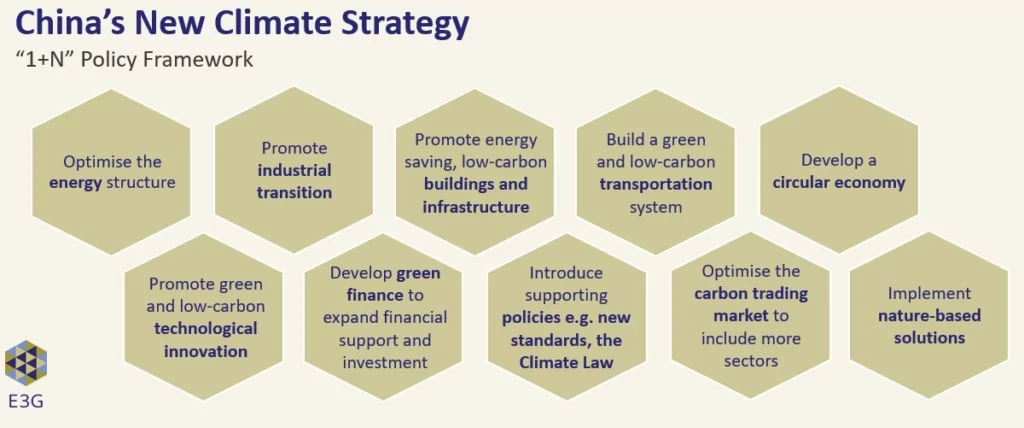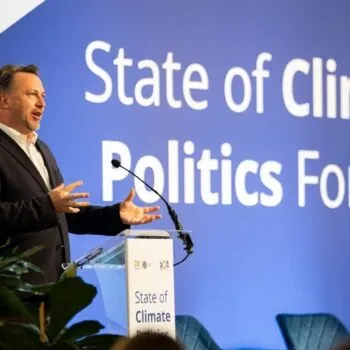The 1+N will be the first major climate policy document from Beijing since it announced its carbon peaking and neutrality targets in 2020.
Since China announced its new climate targets at the United Nations General Assembly in 2020, there has been little official guidance for how these targets would be translated into policies domestically. The 14th Five-Year Plan, China’s overarching social and economic plan published in March 2021, did not outline a clear pathway of how China would align development with the new climate targets.
In May, a working group headed by Vice Premier Han Zheng was set up to lead China’s emissions peaking efforts. It was seen as a move to centralise the authority to drive the policy reforms necessary in line with the country’s climate policy, which currently falls under the purview of the Ministry of Ecology and Environment. The 1+N is one of the key deliverables of Mr Han’s group.
An internal document published by the State Council in September, that was leaked to the Chinese press today, did provide the first glimpse of Beijing’s thinking on the overarching guidance on decarbonisation across a range of sectors. The document includes suggestions of oil consumption “plateauing” in five years’ time, a carbon neutrality legislation and a new target to increase the share of non-fossil energy share to over 80% by 2060.
What’s in a name?
Xie Zhenhua, China’s climate envoy, gave us a preview of the 1+N policy in August. He explained that the “1” refers to the “guiding opinions” that sets out the overarching principles of all forthcoming policies that aim to facilitate China’s peaking and neutrality goal. The “N” will include a “carbon peaking action plan” – a 10-point plan that sets out Beijing’s expectations on the actions that key sectors are required to take to peak emissions. It will cover actions from all major emitting sectors (energy, industry, infrastructure, and transport) as well as other key policy areas for climate action (circular economy, technology, finance, economic policies, carbon trading, nature-based solutions).
What’s in the plan?
On energy, the plan is expected to reiterate China’s pledge to build a “power system based on new energy” (which includes green hydrogen and nuclear), “strictly limit” coal consumption until 2025 and phase it down thereafter. The plan will also cover, Mr Xie noted, measures to “regulate” oil consumption and improve energy efficiency.
The 1+N, alongside China’s impending NDC revision, is an opportunity for Beijing to showcase any new targets in its climate and energy policy. Policymakers in the UK will examine these new policy plans closely to assess if China is ready to contribute to a key COP26 outcome on “consigning coal to history”. Getting China to end new construction of coal power plants is also a key diplomatic priority for the US and the EU.
Given the ongoing power crunch in China and Beijing’s plan to build more “efficient” coal power plants in response, it would be crucial for the 1+N to showcase that recent measures to ramp up coal production are short-term in nature by putting a clear expiry date for coal in China’s power system.
Industry accounts for 36% of China’s total CO2 emissions. The new plan will highlight the need for some emission-intensive sectors to peak their emissions earlier than the national target of 2030. The plan will aim to prioritise “upgrading” traditional industries such as energy, steel, nonferrous metals, chemicals and building materials.
Industry associations have already announced targets for the aluminium and steel sector to peak by 2025 and cement to peak by 2023. These need to be translated into binding policy targets, in either the 1+N or the forthcoming sectoral Five-year Plans.
It will also be key that these sectors achieve a steep emissions decrease following their peak. Setting public procurement standards and scaling up circular economy will be crucial in this regard. The steel sector specifically, which accounts for 17% of China’s emissions, will need to ramp up the closure of excess steelmaking capacity and retrofit the remaining coal-based blast furnaces.
Beyond carbon emissions, Mr Xie said that forthcoming 1+N policies will also strengthen the control of non-CO2 emissions such as HFCs, building upon the momentum of China’s recent commitment to accept the Kigali Amendment of the Montreal Protocol and further announced steps to reduce non-CO2 emissions including methane.
The 1+N will set the direction of travel of China’s green transition and provide the political guidance for China’s climate policies for years to come. It would be an opportunity for China to show it is serious about delivering its climate pledges ahead of COP26.




